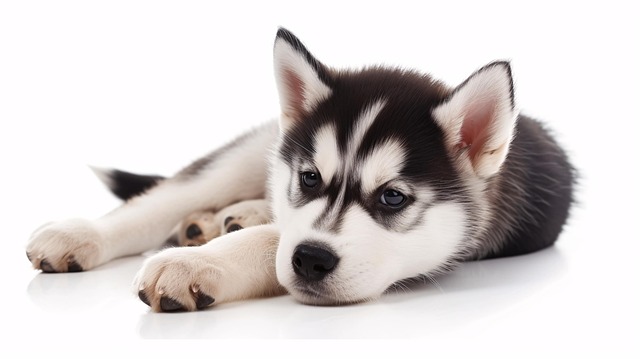
How do i train my dog to be obedient?
Watching your dog dart across the park ignoring your calls isn’t just frustrating—it can put them at risk near busy streets or public spaces.
Huskies are deeply loved by pet owners for their unique appearance and lively personality. However, young Huskies are full of energy, and it's not an easy task to get them to enter the crate obediently. In fact, as long as you master scientific methods and guide them patiently, you can help young Huskies get used to the crate. Reasonable crate training can not only provide them with a safe and comfortable space but also help them develop good living habits, enabling a more harmonious co - existence between owners and dogs.
I. Pre - training Preparations
Selecting the Ideal Crate
The size of the crate should be appropriate. A too - small crate will make the young Husky feel depressed, while a too - large one will make it lack a sense of security. An ideal crate should allow it to stand up, turn around, and lie down freely. For the material, you can choose sturdy and well - ventilated metal or plastic. Ensure that the cage door opens and closes smoothly and there are no sharp edges to avoid injuring the dog.
Creating a Cozy Little Nest
Line the crate with a soft mat, place its favorite toys inside, and add a clean water bowl. The mat allows the young Husky to rest comfortably, the toys can relieve its boredom and anxiety, and the water bowl ensures it can hydrate at any time. Such an arrangement can make it feel close to the crate.
Establishing a Positive Association
Before training, don't force the young Husky to enter the crate. Instead, place some small treats around the crate and let it explore freely. When it approaches the crate, give praise and treat rewards, so that it associates the crate with nice things and forms a positive impression of the crate.
 II. The Step - by - step Training Process
II. The Step - by - step Training Process
Guiding it into the Crate
Use the young Husky's favorite treats to attract it. Stand at the crate door, call its name while slowly putting the treats into the crate to guide it to enter. As soon as its front feet step into the crate, give treats and praise, so that it knows there are benefits to entering the crate. At the beginning, it may be afraid. Be patient, try more times, and never force it.
Brief Stays
After the young Husky voluntarily enters the crate, don't close the door at first. Let it stay inside for a while. Continue to feed it treats, stroke it, and talk to it softly to make it feel relaxed. Gradually extend the staying time from a few seconds, adjusting according to its mood. If it gets anxious, let it out first.
Closing the Crate Door
After it can stay in the crate comfortably, soothe its emotions before closing the door, and then close the door slowly and gently. After closing the door, stay beside it, interact with it, and give treats. At the beginning, keep the door - closed time short, and then gradually extend it, adjusting according to its acceptance level.
Increasing the Departure Time
After the young Husky gets used to staying in the crate with the door closed for a while, start to gradually increase the time you leave it. First, leave for a few seconds and then come back to reward it, and then gradually extend the time. If it gets restless, wait until it calms down before going back, so that it can get used to being alone.
III. Precautions during Training
Maintaining Patience and Consistency
Training requires time and patience. Each dog has a different learning ability. Always be patient during training. Don't scold or hit the young Husky just because it doesn't meet the requirements. Also, keep the training methods and rules consistent.
Avoiding Punishment
During training, don't punish the young Husky for not entering the crate or making noise. This will make it fear and dislike the crate. If it doesn't perform well, calmly analyze the reasons, adjust the methods, or give care and comfort.
Appropriately Giving Rewards
Rewards are the key to training. Timely give rewards such as treats, toys, strokes, or praise to the young Husky. Adjust the degree of reward according to its performance to stimulate its enthusiasm.
Paying Attention to Emotional Changes
Pay attention to the young Husky's emotions during training. If it shows emotions such as nervousness or fear, stop training immediately and give comfort. Also, pay attention to the training time and frequency to avoid over - tiring it and causing excessive stress.
Training a young Husky to enter the crate requires patience, love, and time. Through scientific methods and positive guidance, it can get used to and even love the crate, creating a warm and harmonious living environment for it.

Watching your dog dart across the park ignoring your calls isn’t just frustrating—it can put them at risk near busy streets or public spaces.

New puppy owners often find themselves rushing to clean up accidents before they set in, and that’s where puppy pad training becomes a game-changer.

If you've noticed your dog's waistline disappearing and your veterinarian has mentioned those few extra pounds, your first instinct might be to simply reduce the amount of food in their bowl.

Training a dog to use a designated spot indoors isn’t as daunting as many new owners fear, but it does take consistency and an understanding of your pet’s needs.

That moment of dread on a walk is all too familiar for many new dog owners. You see another dog approaching down the sidewalk of your neighborhood

If the sight of another dog on your neighborhood walk makes your heart sink as your own dog erupts into a frenzy of barking and lunging, you're not alone.